MARIANI’S
Virtual
Gourmet
February 18,
2018
NEWSLETTER
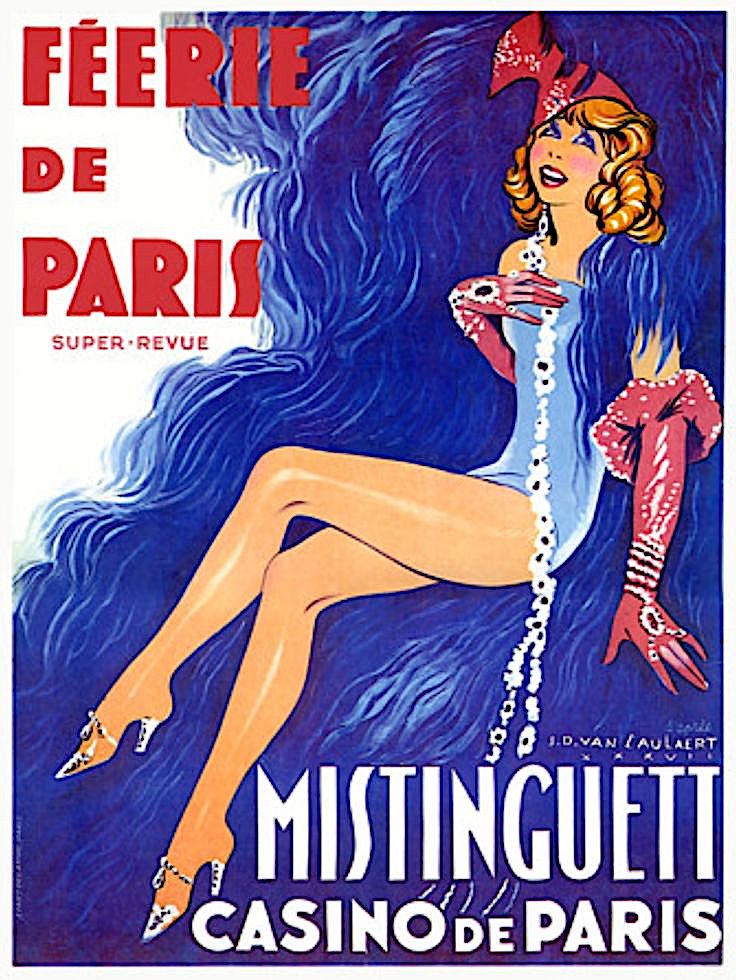
❖❖❖
IN THIS ISSUE
WHAT'S BLOOMING IN DALLAS?
By John Mariani
NEW YORK CORNER
ADORO LEI
By John Mariani
NOTES FROM THE WINE CELLAR
WHAT'S NEW IN
TRADITION-BOUND CHAMPAGNE?
By John Mariani
❖❖❖
WHAT'S BLOOMING IN DALLAS?
By John Mariani
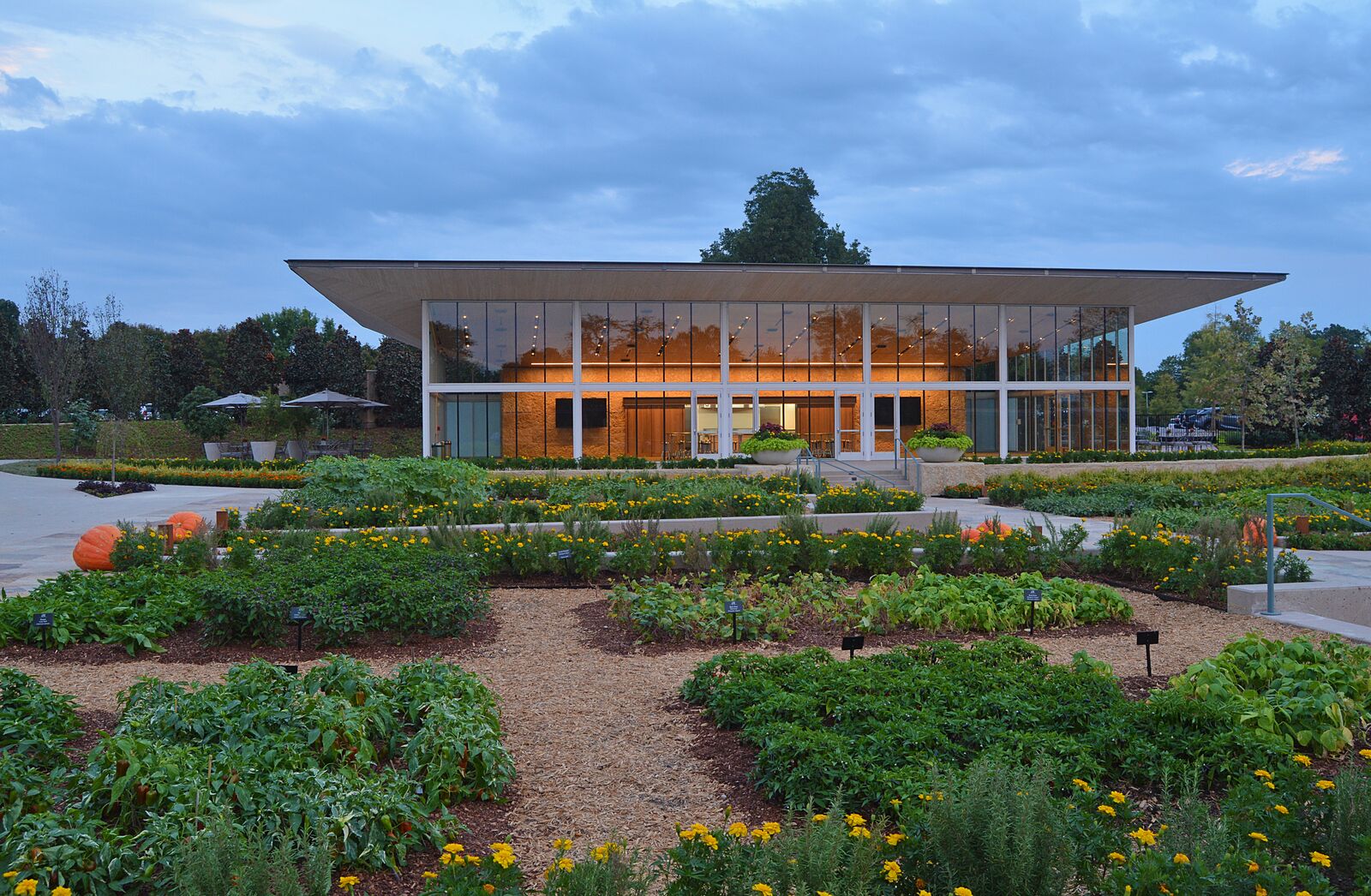
Charlotte and Donald Test Kitchen at the Dallas Arboretum and Botanical Garden
In the Texas culture wars among
Dallas, Houston and Austin, Big D has been
investing heavily in making the city a Southwest
hub for art, architecture and modern museums,
doing so by hiring some  of the best architects
in the world: Renzo Piano did the Nasher
Sculpture Center, Thom Mayne did the Perot
Museum of Nature and Science, Robert A.M. Stern
the George W. Bush Presidential Library and
Museum, and Naud Burnett Landscape Architects
just did a unique addition to the Dallas
Arboretum and Botanical Garden called A Tasteful
Place (right),
a $12 million, 3.5-acre ornamental garden,
pavilion and kitchen, along with the Margaret
and Jay Simmons Lagoon.
of the best architects
in the world: Renzo Piano did the Nasher
Sculpture Center, Thom Mayne did the Perot
Museum of Nature and Science, Robert A.M. Stern
the George W. Bush Presidential Library and
Museum, and Naud Burnett Landscape Architects
just did a unique addition to the Dallas
Arboretum and Botanical Garden called A Tasteful
Place (right),
a $12 million, 3.5-acre ornamental garden,
pavilion and kitchen, along with the Margaret
and Jay Simmons Lagoon.
The Arboretum itself—which Dallas boosters boast
has always operated in the black—was named “One of
the World’s 15 Most Breathtaking Gardens” by Architectural
Digest. A
Tasteful Place goes well beyond the traditional
mission of most other botanical gardens. According
to the architectural firm’s president, Kevin
Clark, the six-year project was always focused on
sustainability and the 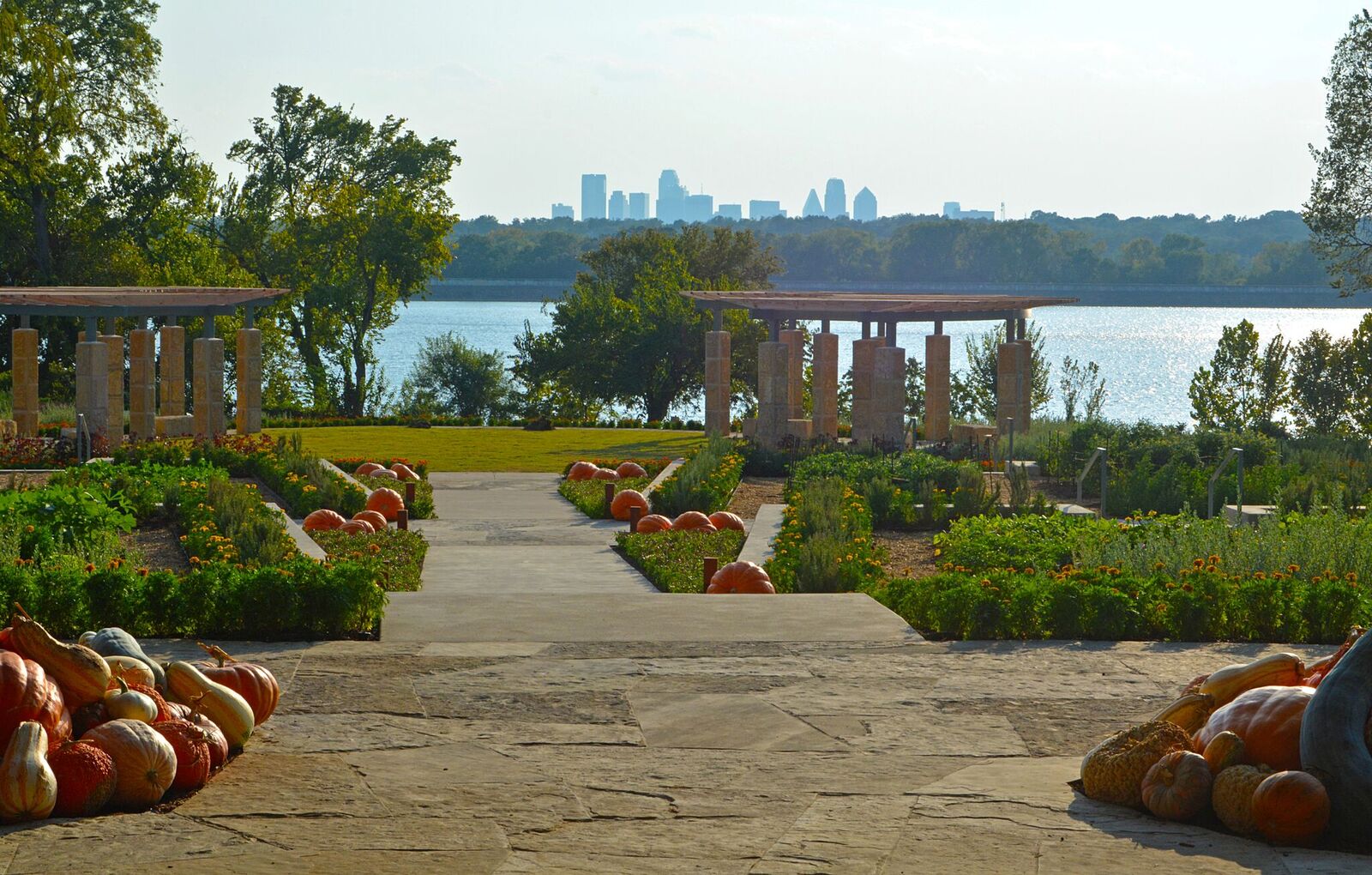 propagation of plants
and vegetables that will be used in cooking
classes at the glassed-walled Charlotte and Donald
Test Kitchen, in conjunction with partners that
include the Dallas County Master Gardeners and
Master Wellness program of Texas A&M AgriLife;
El Centro College; the Department of Clinical
Nutrition, UT Southwestern School of Health
Professionals and the Center for Human Nutrition;
UT Southwestern Medical Center; and Texas Woman’s
University Department of Nutrition & Food
Sciences.
propagation of plants
and vegetables that will be used in cooking
classes at the glassed-walled Charlotte and Donald
Test Kitchen, in conjunction with partners that
include the Dallas County Master Gardeners and
Master Wellness program of Texas A&M AgriLife;
El Centro College; the Department of Clinical
Nutrition, UT Southwestern School of Health
Professionals and the Center for Human Nutrition;
UT Southwestern Medical Center; and Texas Woman’s
University Department of Nutrition & Food
Sciences.
The modernity of the design incorporates the latest environmental technology, like using gunite and bentonite to create the bottom of the lagoon, which will enable the Arboretum to collect rainwater and run-off to fill the lagoon, planted with water lilies, water pickerel, water bacopa, water poppy and lizard tail.
At night the lighted fountain changes colors and sprays 20 feet in the air, while a brook runs under a bridge and connects other sections of the 66-acre Arboretum, incorporating hardy trees like October Glory Maples, Ginkgo, Bur Oaks, Live Oaks, Magnolias, Japanese Maples, Golden Rain Trees, and Vitex Trees that will provide various changing colors throughout the year. In the children’s Adventure Garden, water is used to generate electricity as well as water fountains and misters in the hot, humid Dallas climate.
“From the walkways [around it], we’re
intentionally trying to obscure the views of A
Tasteful Place until the last moment,” says Clark,
 “so that
once you step inside, you have those ‘a-ha!’
moments.”
“so that
once you step inside, you have those ‘a-ha!’
moments.”
Also new to the city’s
cultural landscape is the Texas Sculpture Walk in
the downtown Dallas Arts District, said to be the
largest contiguous urban arts district in the
nation. More
than 20 works by prominent Texas artists were
installed along the walkway from the private
collection of Craig and Kathryn Hall, whose
180-story, LEED Gold Certified KPMG Plaza at Hall
Arts opened three years ago, done by architectural
firm HKS Inc. The 50,000-square-feet property also
includes the city’s most acclaimed new restaurant,
Stephan Pyles’ Flora Street Café (below), and
the Asian fusion concept Musumé.

Houston still likes to brag
about its size and Lone Star heritage, and Austin
promotes its music and hipsterism. But as Dallas
keeps building outward and upward during the
current economic boom, the smart money is on the
arts and culture for the long run.
FLORA STREET CAFÉ
2330 Flora Street
214-580-7000
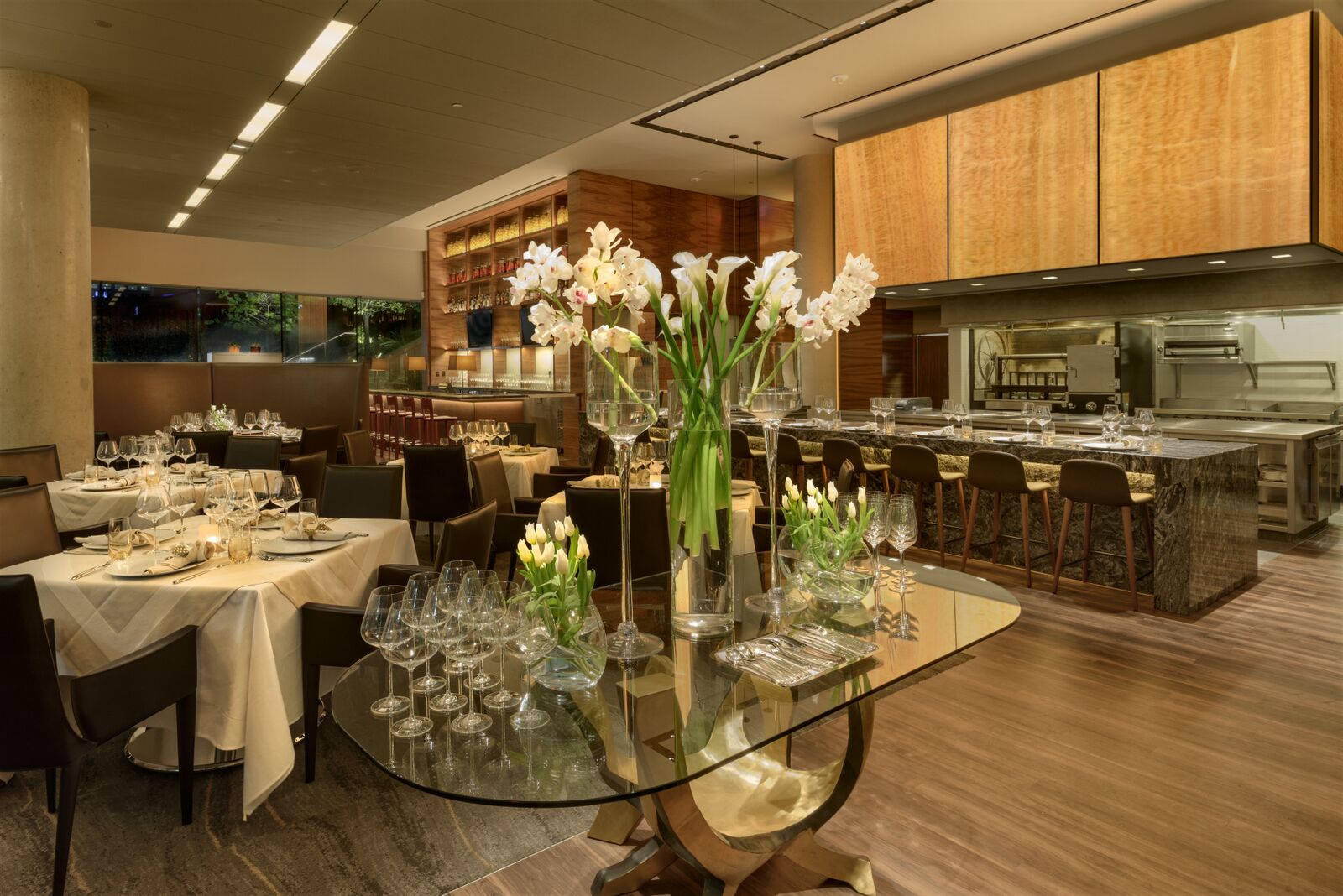
Stephan Pyles has for four
decades been the city’s most innovative chef for
his elegant Southwest modern cuisine, and his new
restaurant was designed by Jim Rimelspach of
Wilson Associates to fit impeccably into the
Dallas Arts District. A jellyfish-like lighting
fixture moves up and down, opening and closing
from the ceiling, and the chandeliers mimic those
of famous opera houses around the world. A
canopy of backlit amber alabaster panels are
suspended over a wide open kitchen and bar, while
a large abstract 3D tapestry overlooks the dining
room, and a floor-to-ceiling, mirrored étagère
holds jars of red chili peppers and yellow lemons.
The room is, though, very loud at peak 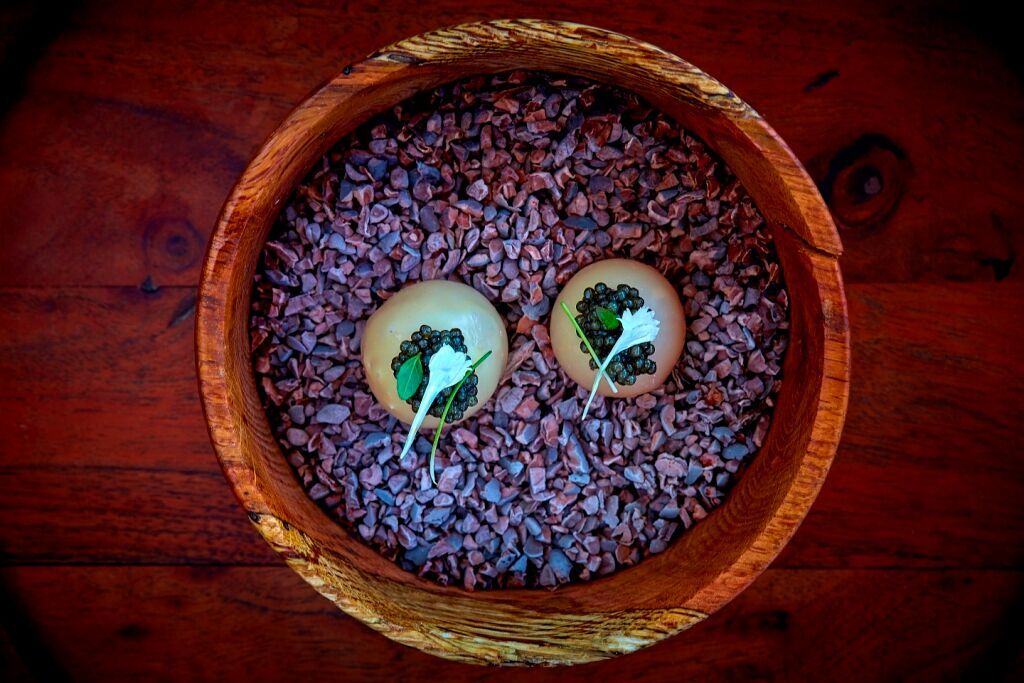 period,
and the throbbing music only adds more sound to
detract from conversation. I would have thought
the designer wold have put in baffling.
period,
and the throbbing music only adds more sound to
detract from conversation. I would have thought
the designer wold have put in baffling.
As I mentioned to Pyles when I dined there, most
chefs cook in a simpler style as they grow older,
but at his new place he is doing more complex food
than ever before.
The menu descriptions go on and on, so you
don’t need the waitress to vocalize them.
Nevertheless,
Broken Arrow Ranch venison tartare with green
tomato, smoked Halloumi, huevo negro,
and spiced Waco rice crisp ($19) is a very
beautiful dish, full of flavors and
textures that complement one another—an
outstanding dish in every way.
The amuses included a cocomelon
with a luscious liquid center, but the roe on top
made it taste a bit fishy. Florida rock shrimp, coconut,
pineapple “textures,” chipotle sorghum popcorn,
and Jasmine see essence ($24) was,
by the same token, overwrought. The
lobster tamale pie ($28) is artfully mounted in a
large Martini glass, dotted with wild paddlefish
caviar and ancho pepper "glass" that tingles on
the tongue (below).
The
on-premises baked breads are terrific here.
I was wild abut the intense flavor of
crispy Colorado lamb belly with
avocado-watermelon, huarache, creamer Peas and spicy
salsa verde
($19), the kind of dish Pyles has always made his
signature, and Amish chicken roulade with mojo-rojo,
peas, poblano quesadilla and cauliflower al pastore
($19) shows how he can meld Mexican flavors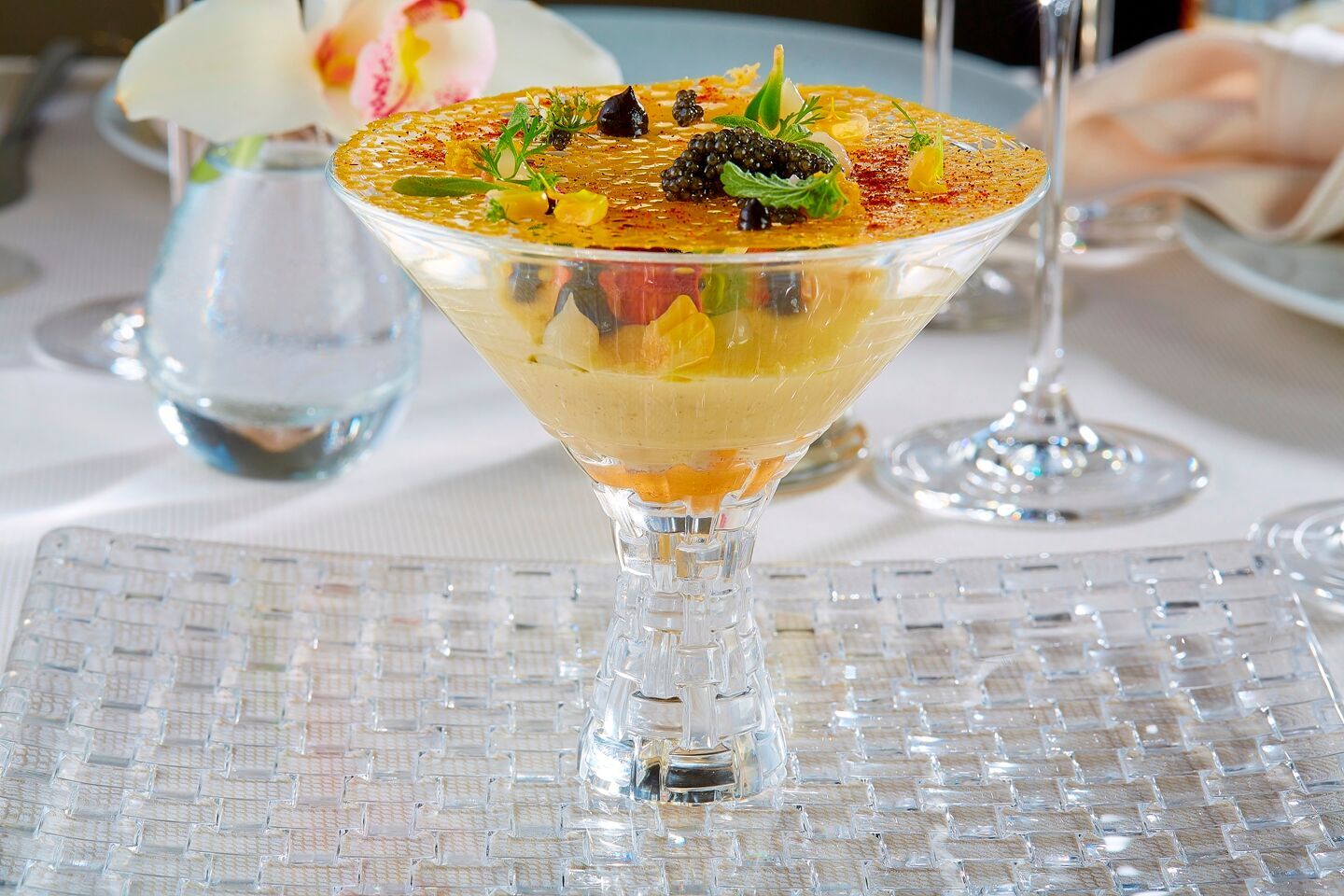 so
impeccably with American ingredients. Saline
North Carolina country ham added measurably to the
taste of silky sea scallops that
had a tangerine crust and a sweet eggplant puree
($48). But best of all I tasted was Texas wagyu
ribeye brisket with grilled okra, baby roots, and
Mole Negro ($52), which showed this cut to be far
more interesting than an unctuously fatty
slab of wagyu.
so
impeccably with American ingredients. Saline
North Carolina country ham added measurably to the
taste of silky sea scallops that
had a tangerine crust and a sweet eggplant puree
($48). But best of all I tasted was Texas wagyu
ribeye brisket with grilled okra, baby roots, and
Mole Negro ($52), which showed this cut to be far
more interesting than an unctuously fatty
slab of wagyu.
Desserts are equally as well
thought through, like the tres leches crèmeux
with Texas peach ice cream then in season, dulce de leche
and the nice citrus tang of verbena ($10), and a
cassis parfait with hibiscus sorbet, brown flower
sable and berry-glazed jicama ($10).
A night out at the Flora Street Café will be
expensive, but no one will complain about the
portions, the number sides on a dish or the
overall sumptuousness of the experience here.
Combine it with one of the city's best wine lists,
and it’s easy enough to see why this is a tough
reservation to snag on short notice.
Open for lunch Mon.-Fri.; for dinner
Mon.-Sat.
❖❖❖
By John Mariani
287 Hudson (between
Spring and Canal)
646-666-5096

It was a little off-putting when
I read Adoro Lei’s menu with names for its
pizzas that include “Worship Wings,”  “Boozy Bettina” and
“Tempted to Touch.” (You can only imagine what
the cocktails are named.) Also, from photos of
the place, the owners seem to stress a nightclub
vibe and glam crowd rather than the food.
“Boozy Bettina” and
“Tempted to Touch.” (You can only imagine what
the cocktails are named.) Also, from photos of
the place, the owners seem to stress a nightclub
vibe and glam crowd rather than the food.
Yet walking into Adoro Lei (Italian for “I adore her”), our party was well received, promptly seated and served by a very engaging young woman who balanced professionalism with an infectious personality and her own fashion style.
The photo appended here (left) doesn’t really show the
color and pizzazz of the dining room, its walls
set with a series of women-with-food images by
artist Dessie Jackson
(left).
The bar, where old movie scenes are looped, was
doing well that night, and, this being Thursday, a
DJ was getting ready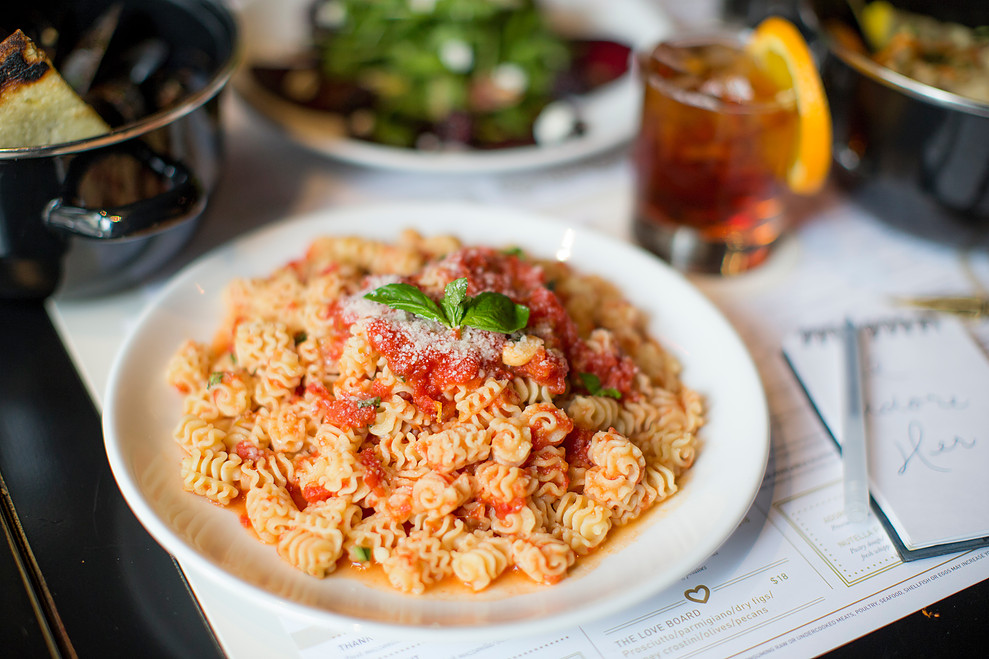 to spin
music certain to make anyone over the age of fifty
squirm.
to spin
music certain to make anyone over the age of fifty
squirm.
The menu is a broadsheet of departments—salads, panini, Share Us apps, soup, entrees, pasta, wood burning vegetables, and, smack in the center, eighteen pizza variations ($12-$20). Chef Mario Gentile knows very well how to make true Neapolitan-style pizza, not the ultra-thin crackling kind popular elsewhere. His are puffy, yeast-scented and pliant. I didn’t deliberately avoid the goofy-name pizzas but ordered what sounded the most savory, all made with a first-rate crust impeccably baked in a wood-burning oven smoking away in the background. A Romeo pie was topped with good spicy sausage, peppers, sweet onions, tomato sauce and fresh mozzarella, while a Simonetta had onions caramelized in Sherry wine, stracciatella and herbed goat’s cheeses and “exotic mushrooms,” which were not. Charlotte contained braised veal-and-pork meatballs, creamy ricotta, mozzarella and tomato sauce. Next time I may be tempted by a Niccolo with fennel and soppresatta, or the fried pizza.
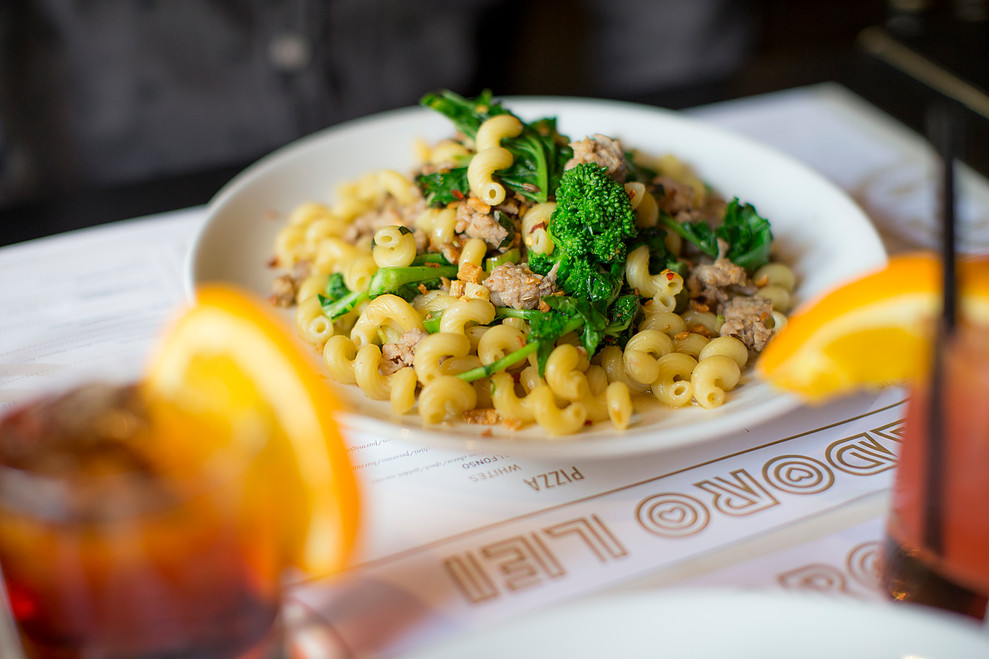 The
two “Share Us” appetizers we tried were
bland—chewy fried calamari and lobster mac &
cheese—but a side dish of roasted Brussels sprouts
cauliflower with caramelized onions, red pepper
flakes, lemon and pecorino ($9) was very good. A
generous portion of eggplant “parm” ($17), now
making a big comeback around town, was scooped up
quickly by everyone at my table, and the “lover’s
purses” of pasta stuffed with cheese, sweet ripe
pear in a brown butter and sage sauce with roasted
walnuts, arugula and Parmigiano shavings was
overwrought but a dish very much fit for lovers to
share ($22 or $32).
The
two “Share Us” appetizers we tried were
bland—chewy fried calamari and lobster mac &
cheese—but a side dish of roasted Brussels sprouts
cauliflower with caramelized onions, red pepper
flakes, lemon and pecorino ($9) was very good. A
generous portion of eggplant “parm” ($17), now
making a big comeback around town, was scooped up
quickly by everyone at my table, and the “lover’s
purses” of pasta stuffed with cheese, sweet ripe
pear in a brown butter and sage sauce with roasted
walnuts, arugula and Parmigiano shavings was
overwrought but a dish very much fit for lovers to
share ($22 or $32).
There are beignets and Italian cookies for dessert, if you’re still hungry. The slender wine list is nothing to cheer about.
By nine p.m. the music was getting louder and the vibe of Adoro Lei shifting into high gear, so anyone considering a relaxing visit should get there around seven. You’re in for big flavors and big portions. You’ll have a very good night of it and probably take some food home.
❖❖❖
TRADITION-BOUND CHAMPAGNE?
An Interview with Moët &Chandon's Benȏit Gouez
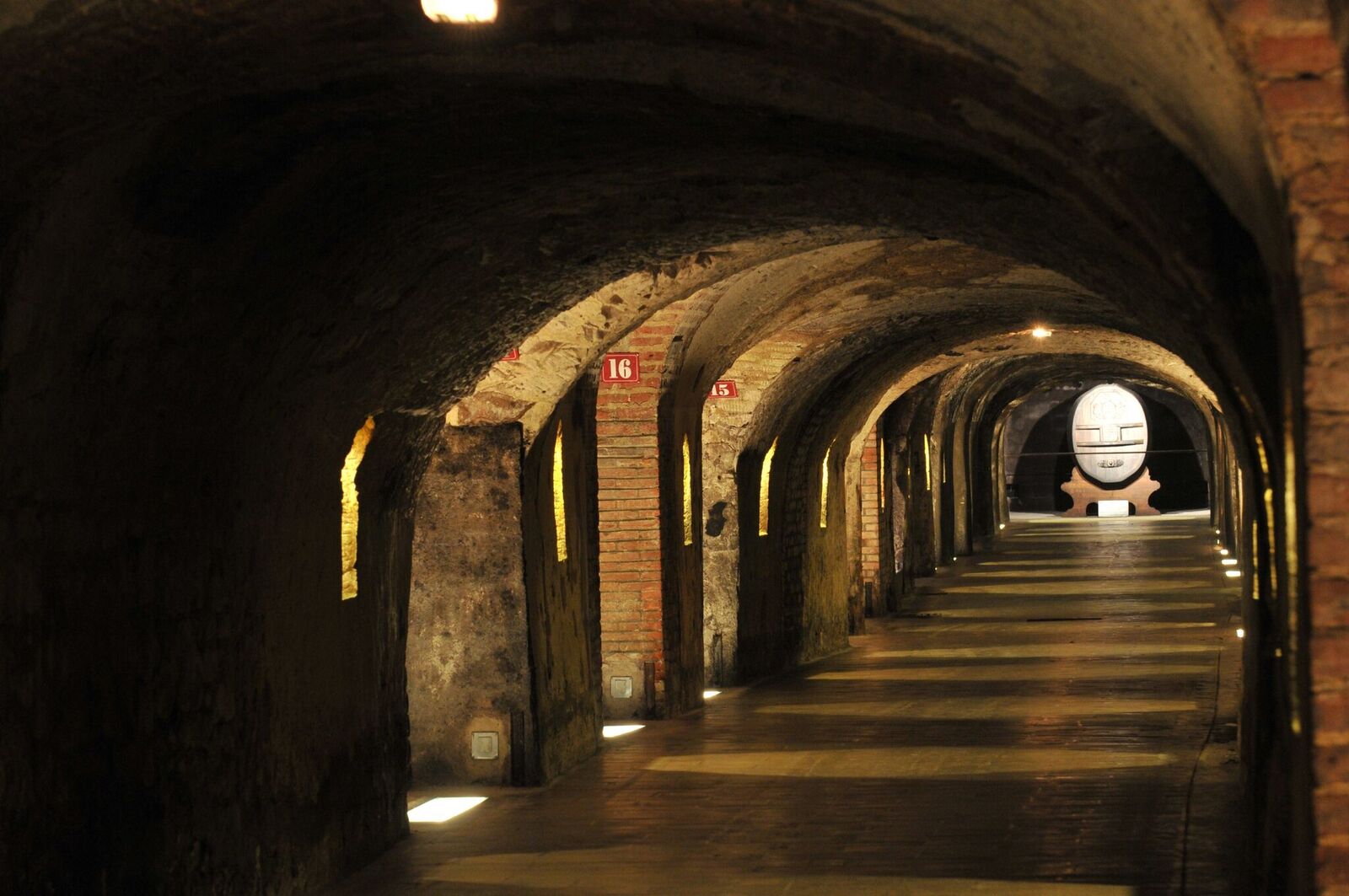
The caves at Moët-Chandon, Épernay
As
it should be, the great wine estates of
France are tied to traditions that have
consistently made their products among the
finest in the world, as much for Champagne
as for Bordeaux and Burgundy. Still, wars,
economic depressions and change of ownership
have always affected the Champagne regions
of Reims and Épernay, 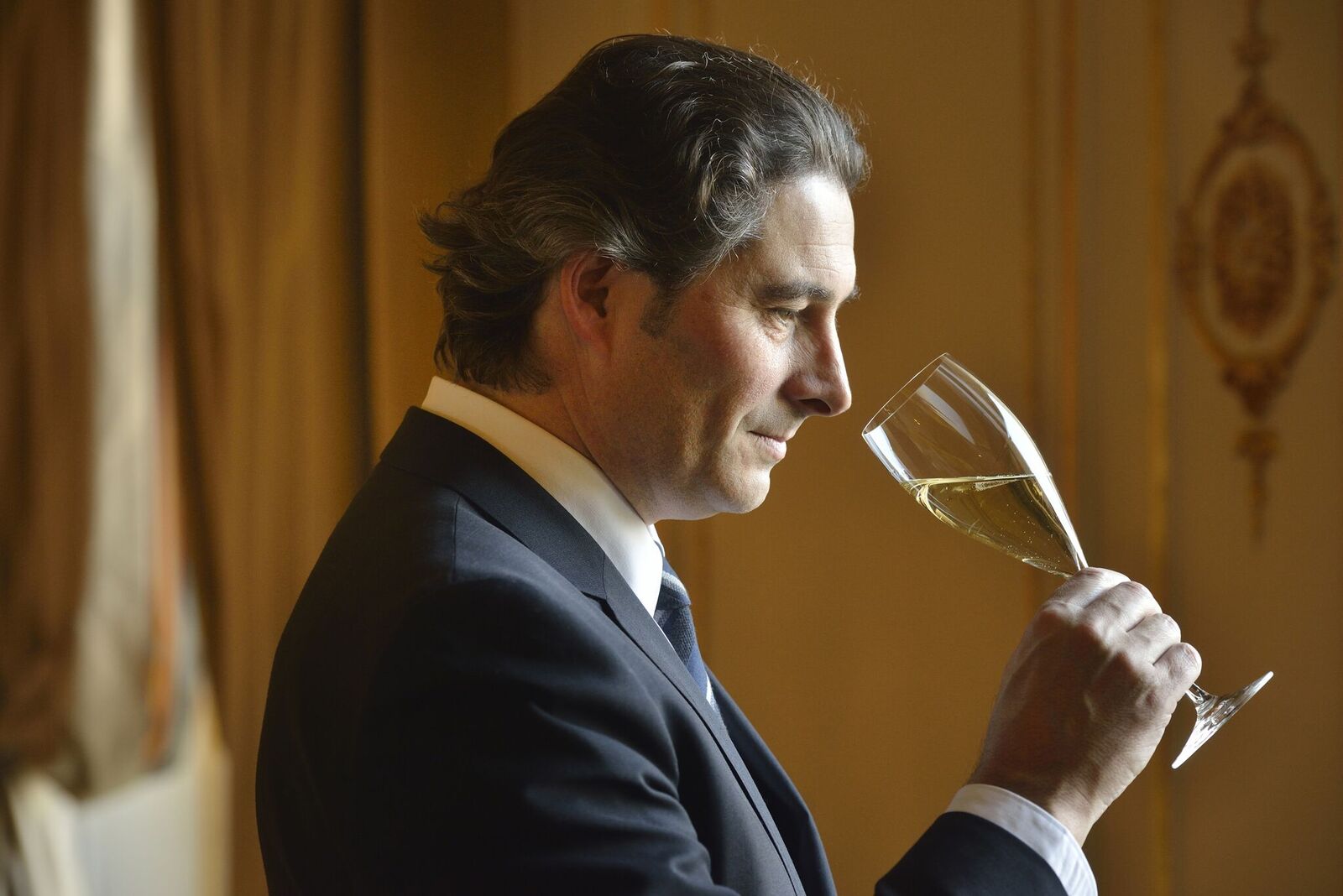 while
technology has improved the overall product,
even if the sacrosanct méthode
champenoise technique remains tied to
the18th century.
while
technology has improved the overall product,
even if the sacrosanct méthode
champenoise technique remains tied to
the18th century.
To bring me up to
date I sat down with Benôit Gouez (left),
48, for thirteen years Chef de Cave at Moët
& Chandon (below), over dinner at New
York’s Gabriel Kreuther restaurant and learned
there is much that is new among so much that
is old in the sparkling wine industry.
Gouez, who looks a bit like a younger
French version of Robert DeNiro, is hardly
alone in wanting to promote Champagne beyond
its special occasion image, noting that while
300 million bottles of the French bubbly are
produced each year, the French drink up half
of it.
“You know, Champagne
is very much a global wine,” he said.
“Champagne invented marketing! Everyone knows
it around the world, and when people see
others drinking it from a nice Champagne
glass, they think, hmm, I think I’d like a
glass for an apéritif or over dinner. People
are drinking it in a more casual way, even
over ice.”
When I asked if he
thought pouring Moët on the rocks was a little
demeaning to Champagne’s image, Gouez shrugged
and said, “If you’re sitting in the sun on the
French Riviera or in Miami, the idea of
Champagne on ice makes a lot of sense.”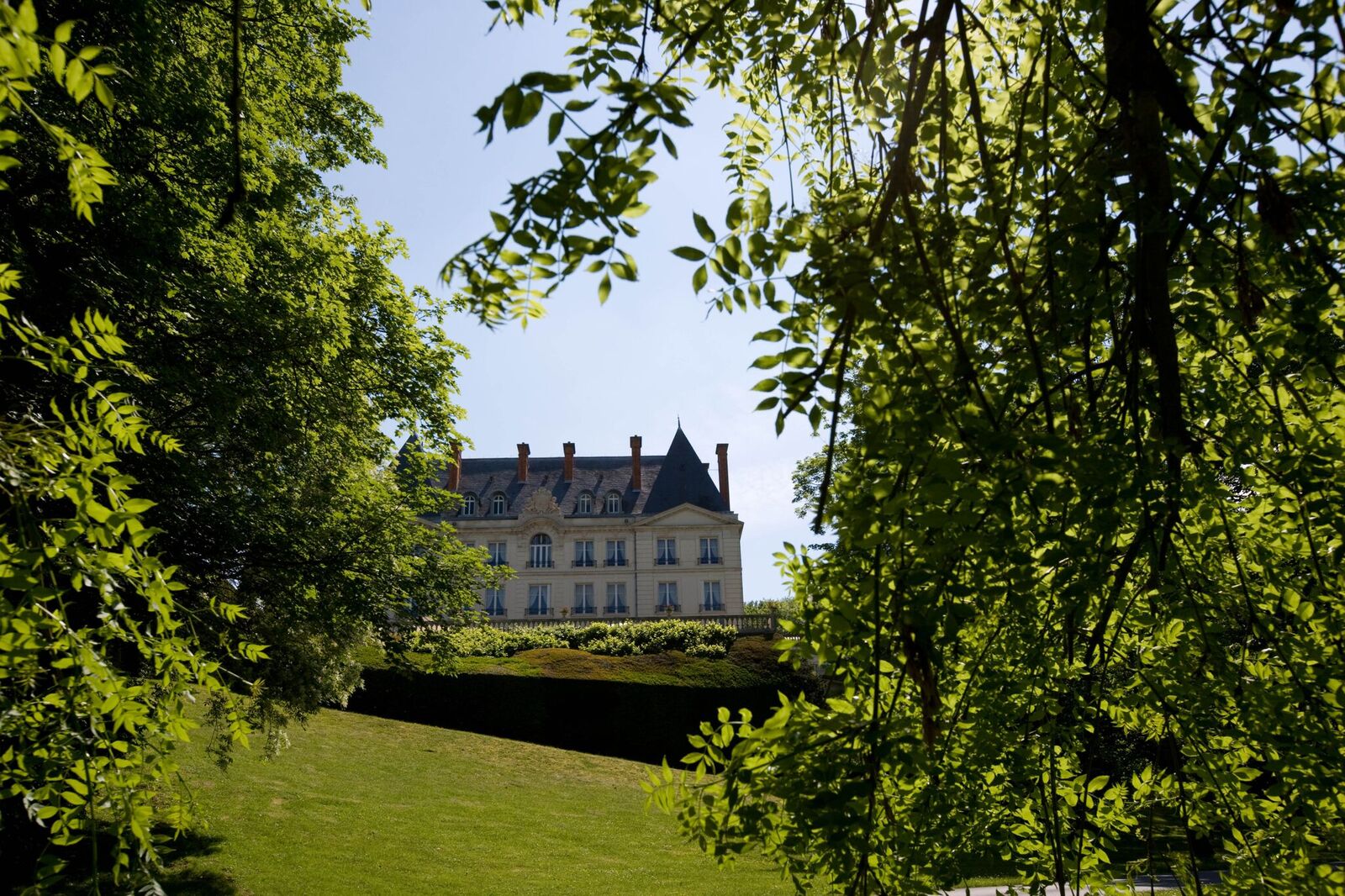
I asked
if sales of Italian prosecco and Spanish
cavas, which are always cheaper than even
entry-level Champagnes, have affected
Champagne sales. Gouez replied, “No, except
for those Champagnes that shouldn’t exist.”
He also contended
there has been a renewed interest in sweeter,
demi-sec
Champagnes after decades when bone-dry
examples garnered all the cachet. I
told him I have long thought that most of the
préstige
cuvée Champagnes called pas
dosage—by which the traditional small
amount of liquid sugar (dosage)
used to balance acidity is not used
lack
the cherished fruit flavor Champagne should
have. Gouez did not disagree, saying quite
pointedly, “Pas
dosage has more to do with an
intellectual vision, not with pleasure. The dosage helps
the wine recover from the possibility of
oxidizing after fermentation of the natural
sugar in the grapes.” He then admitted that
sales of préstige
cuvées are minuscule: “Sales people
talk about them, but people don’t drink them.”
Although Gouez has
been with Moët for only 20 years, 13 as Chef
de Cave, he has a comprehensive knowledge of
the wines’ history over the past 150
years. 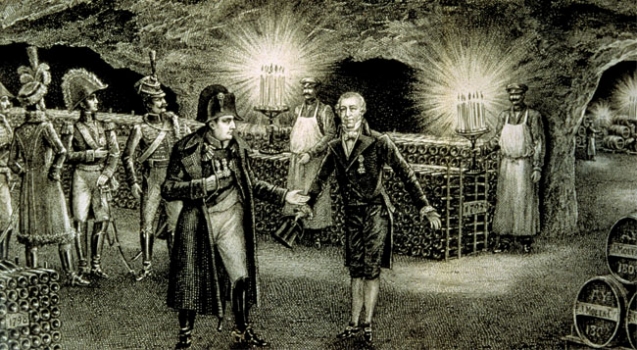 Napoleon was a visitor (left).
“I’ve tasted some very old Champagnes that
were well made and still lively after a
century in the bottle. But up until the
post-war era not all Champagne was very well
made or might be made from inferior grapes and
stocks. In the 1930s they had much lower
yields, so that the producers in Épernay and
Reims made more from selling potatoes. Even in
the ‘70s and ‘80s there was little that was
extraordinary. Vines were young and they
didn’t control them the way we do today.”
Napoleon was a visitor (left).
“I’ve tasted some very old Champagnes that
were well made and still lively after a
century in the bottle. But up until the
post-war era not all Champagne was very well
made or might be made from inferior grapes and
stocks. In the 1930s they had much lower
yields, so that the producers in Épernay and
Reims made more from selling potatoes. Even in
the ‘70s and ‘80s there was little that was
extraordinary. Vines were young and they
didn’t control them the way we do today.”
To
Gouez every harvest is different, even though
Moët’s Brut Impérial is the epitome of the
label’s consistent style. The blend was
created in 1869 and is now made from more than
100 different wines, 20% to 30% of them
reserve wines. It matures in the cellar for 24
months, then for at least three in bottle. The
style is definitely fruit rich, sprightly with
fine bubbles and very appealing with a wide
range of tastes. At $39 it may be the best buy
from a great marque
you’ll find.
For vintage-dated
Champagnes he believes no years should be the
same: “We vary the percentage of Pinot Noir,
Chardonnay and Pinot Meunier. The
effervescence must be taken into account.”
I asked if climate
change and global warming have had an effect
on Champagne production. “We have data on
climate and temperature going back to the
1940s,” he said, “and we’ve looked at ten-year
averages and clearly see a curve. From 1940 to
1988 the sugar decreased, but since 1988 the
opposite is true. The heat causes the grapes
to have more sugar, which up until now has
been a positive thing, but we don’t know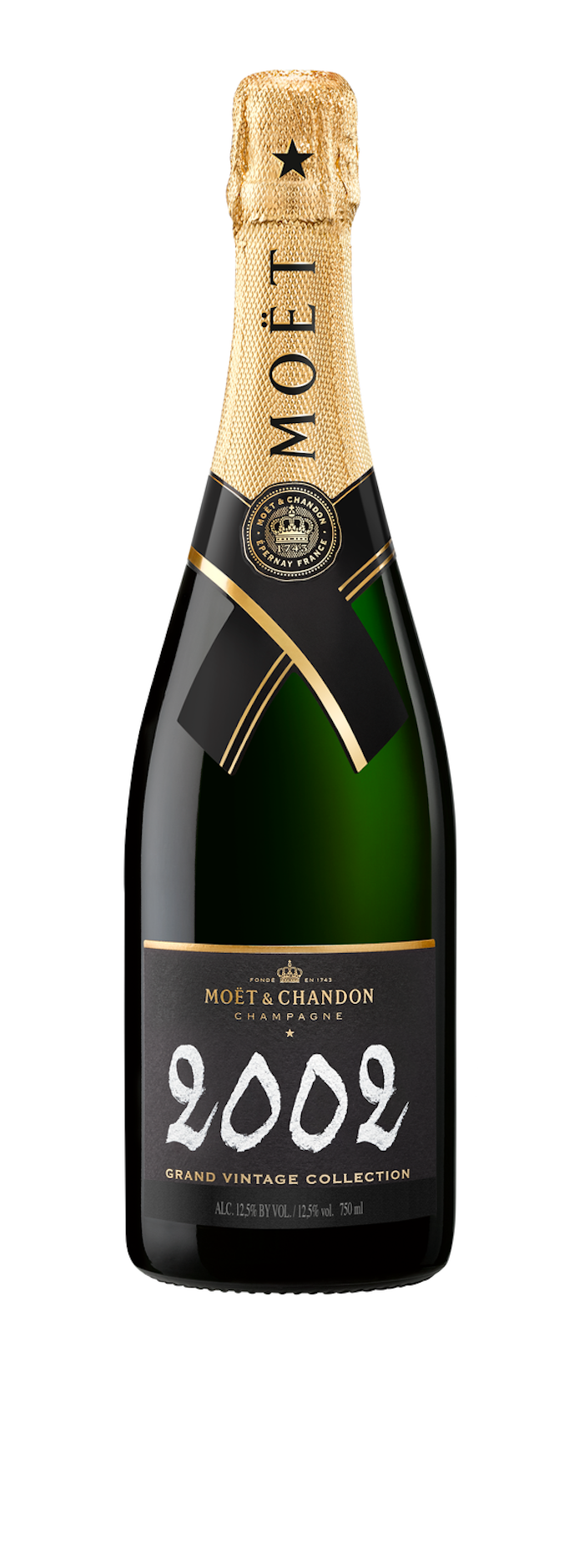 about
the future if things continue to change. I do
know we are harvesting earlier than ever. We
never used to harvest in August in the last
century; now we do.”
about
the future if things continue to change. I do
know we are harvesting earlier than ever. We
never used to harvest in August in the last
century; now we do.”
We also tasted two
wines from the Grand Vintage Collection. The
2002 ($140) came from a perfect summer’s
weather, with each vineyard harvested
according to ripeness, some well into
September. The assemblage
is 51% Chardonnay, 26% Pinot Noir and 23%
Pinot Meunier. The disgorgement was done only
one year ago, and Moët is known for holding
its wines back sometimes twice the average
legal requirement. I found it had a rich
plum and peach component, with a pleasing
toasty quality in the finish.
The 2009 ($65) fell
under Gouez’s tenure, when the weather was
perfect and the vintage was one of the finest
of the decade, allowing Gouez ample
opportunity to make the assemblage,
which turned out to be 50% Pinot Noir—the
highest since 1996–-36% Chardonnay and 14%
Meunier. It’s a beautiful Champagne, very
full—you can taste the influence of the Pinot
Noir—with a great deal of complexity, a wine
that will certainly age well but is so
delicious right now that I would not want to
wait.
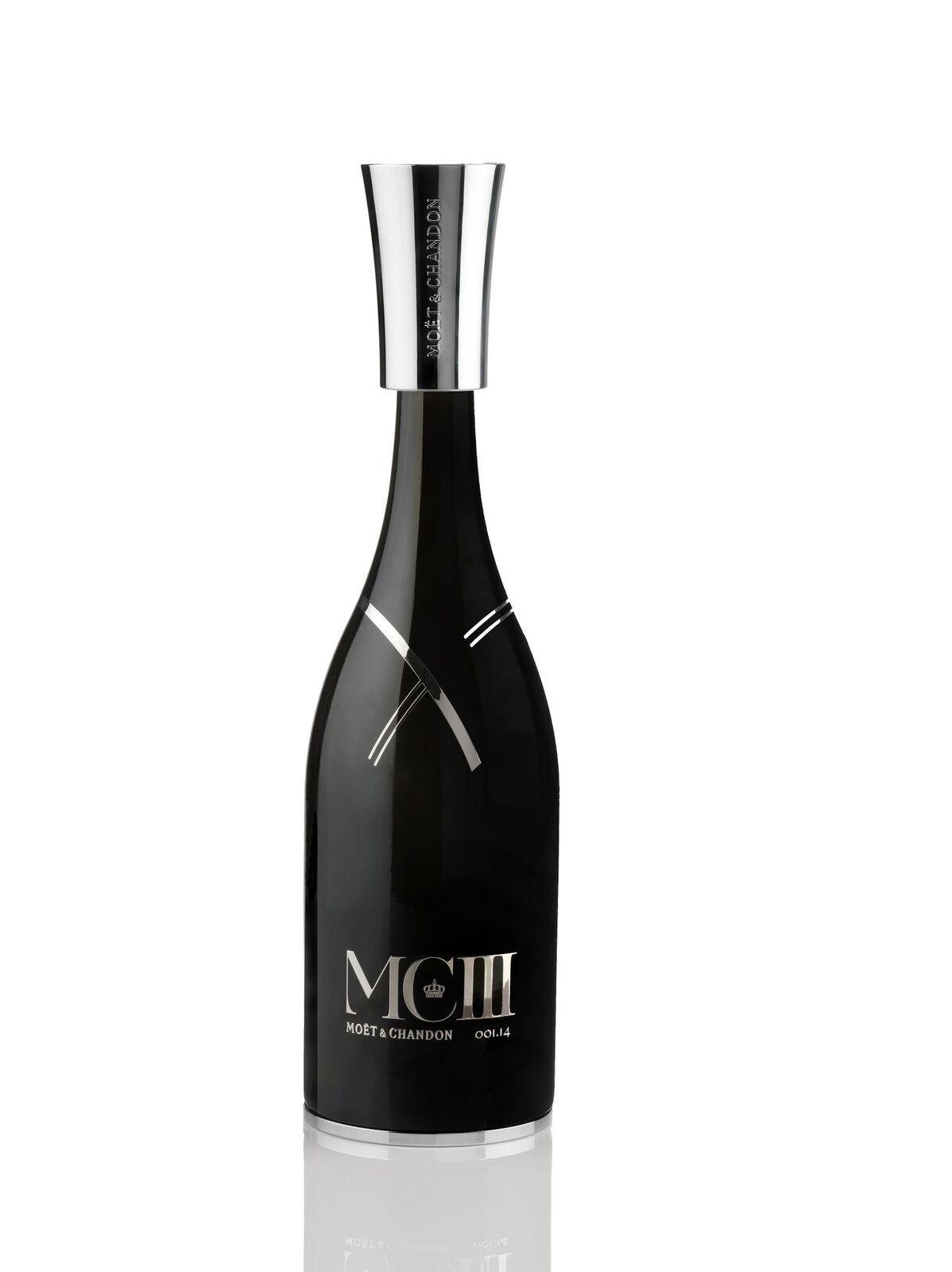 A
brand new production from Moët is called MCIII
($280; in magnum $650), which, said Gouez,
“was twenty years in the making, the ultimate
blend!” It also comes in a dazzling new
bottle, nothing like the traditional Moet
bottles. The name means “Moët & Chandon
Three Strata,” referring to the “perfect integration and
complementarity [sic]
of the assembled wines,” which leads to
“sagas,” that is, “unique expressions.”
A
brand new production from Moët is called MCIII
($280; in magnum $650), which, said Gouez,
“was twenty years in the making, the ultimate
blend!” It also comes in a dazzling new
bottle, nothing like the traditional Moet
bottles. The name means “Moët & Chandon
Three Strata,” referring to the “perfect integration and
complementarity [sic]
of the assembled wines,” which leads to
“sagas,” that is, “unique expressions.”
The Primary Stratum
is “made from the metal universe,” meaning the
most intense Chardonnay and the most
structured Pinot Noir from 2003 that have been
fermented and aged in stainless steel vats to
add an intense fruity wine dimension. The
Second Stratum is from the wood universe, with
Grand Vintage blends 1998, 2000 and 2002 that
have been partially aged in large oak casks,
which integrates “more elements of
transformation and evolution” that “evokes
images of the autumn season.” The Third
Stratum is glass, with Grand Vintage
Collection 1993, 1998 and 1999 aged in bottle
and disgorged, giving the finished wine “a
dimension that is lively and full of vitality
with more roasted notes and depth.”
It all sounds like
Marketing Speak to me, but the wine is a
charming, elegant and complex Champagne that
is probably going to shake up some of the
region’s other grandes
marques to take more novel approaches to
their own wines.
ANNALS OF
STUPID CRIMINALS, PART 2,455
Bradley Hardison (right), a North Carolina competitive
doughnut-eating champion, was convicted for breaking
into a safe at Dunkin’
Donuts.
 AH, YES. . . FOREVER GQ
AH, YES. . . FOREVER GQ
“Like David, Gökçe is indisputably handsome. He’s a
stocky fellow, with the solid physique of a bodybuilder,
and olive skin. One can’t help but notice the pleasing
outline of his clavicle revealed by the deep white
V-neck t-shirt he wears in the video, or the alluring
curvature of his biceps as they emerge from his sleeves.
His hair, long and jet-black, is lustrous; his goatee is
well-kempt and his eyebrows, emerging from a pair of
small, round sunglasses, arc over his brow like the
wings of a majestic eagle. But he did not get famous, hot convict-style, for
his looks alone. At the time the video published, Gökçe
was already a seasoned restaurateur. . . .
Wine
Column Sponsored by Banfi Vintners
SANGIOVESE
Wine is
a joy year-round but in cooler weather one
grape varietal has really taken center stage in my
daily activities – that most Italian of grapes,
Sangiovese, and its ultimate expression – Brunello di
Montalcino.
From
mid-September through mid-October, the Sangiovese
grown for our various styles of red wines are be
harvested, culminating with the top selection for
Brunello di Montalcino.
Second, cooler weather
here means it is time to start enjoying more red wines
and especially Sangiovese based wines. That
includes Banfi’s cru of Brunello, Poggio alle Mura,
literally the cream of the crop of our Sangiovese
vineyards. Alongside our Poggio alle Mura Brunello di
Montalcino, this year we introduced two more wines
from the cru Poggio alle Mura – a Rosso di Montalcino
and a Riserva of Brunello. Rosso is sort of like the
younger brother of Brunello, also made from 100%
Sangiovese grapes but usually a selection from younger
vines and the wine is aged only two years compared to
the four required for Brunello. The
Riserva, on the other hand, is an even more selective
harvest of Sangiovese, and ages for an additional year
before release.
What is so special
about this cru Poggio alle Mura? Well, it is
the result our over 30 years of ongoing research at my
family’s vineyard estate, Castello Banfi. When we
first began planting our vines there in the late 1970s
studies from the University of Bordeaux indicated
which strains of many varietals we should plant, based
on the soil type and microclimate of each vineyard. But when it
came to the region’s native Sangiovese, there was only
local lore, no scientific research. So we took
it upon ourselves to figure out this vine, and set off
on three decades of incredibly detailed research.
We started with 600
apparent variations on Sangiovese, because it is so
susceptible to variations in weather and soil, and
narrowed that down to 160 truly genetically different
clones. We
planted a vineyard with two rows of each type, made
wine from each of them, and charted the differences –
remember, you only get one chance a year to make wine,
so this took time.
It took about ten
years to get some concrete results, though we continue
to experiment today and always will – you never stop
learning in science and nature! Once we
determined which were the best, complementary clones
that could be planted together to make the best
Brunello, we chose to plant them in what we determined
to be the optimal vineyard sites. Coincidentally,
the best soils and climate conditions are in the
slopes surrounding the medieval fortress today known
as Castello Banfi, known since Etruscan times as
Poggio alle Mura – the walled hilltop. Hence the
name of our most special “cru” of Brunello,
representing a synthesis between tradition and
innovation.
Though the focus of
this study was our Brunello, all of our
Sangiovese-based wines, including the super Tuscans
SummuS, Cum Laude, and Centine, benefitted from this
work. And
that’s the third reason for celebrating Sangiovese
this month, for the range of wonderful reds that usher
us into autumn!
One wine in particular was inspired by our
research – the BelnerO, a Sangiovese dominant blend
with what I like to call a kiss of Cabernet and a
whisper of Merlot.
We grow the grapes a little differently for
BelnerO than for Brunello, make the wine with less oak
aging and released it earlier from the winery,
providing a counterpoint to Brunello and a lovely
terroir-driven wine in its own right.
If you know
Italians, you know that by nature we are
multi-faceted, varying in mood, and always passionate. As a
nation, we span from the hot sunny beaches of Sicily
near the African coast to the rugged mountains and
Alpine ski slopes of Trentino-Alto Adige in the north. Sangiovese
is grown in almost all of Italy’s regions and reflects
the unique nature of each; it is most famous
(rightfully so) in Tuscany, yet even there it reflects
the nuances of each hilltop, valley and subzone. It has
something a little different to say in Brunello than
Chianti, Morellino than Vino Nobile di Montepulciano,
Rosso di Montalcino than Super Tuscan blends.
Here is a smattering
of Sangiovese-based wines that you may wish to get to
know better, reflecting a spectrum that appeals to
every occasion, every taste, and every budget. We can
assure you that the conversation will never become
boring.
Recommendations for Celebrating
Sangiovese
BelnerO Proprietor’s Reserve Sangiovese
– A refined
cuvée of noble red grapes perfected by our pioneering
clonal research. This dark beauty, BelnerO, is
produced at our innovative winery, chosen 11
consecutive years as Italy’s Premier Vineyard Estate.
Fermented in our patented temperature controlled
French oak and aged approximately 2 additional years.
Unfiltered, and Nitrogen bottled to minimize sulfites.
Castello Banfi Brunello di Montalcino –
Rich, round, velvety and intensely
aromatic, with flavor hints of licorice, cherry, and
spices. Brunello di Montalcino possesses an intense
ruby-red color, and a depth, complexity and opulence
that is softened by an elegant, lingering aftertaste.
Unfiltered after 1998 vintage.
Castello Banfi Rosso di Montalcino – Brunello's "younger brother," produced
from select Sangiovese grapes and aged in barrique for
10 to 12 months. Deep ruby-red, elegant, vibrant,
well-balanced and stylish with a dry velvety
finish.
Poggio all’Oro Brunello di Montalcino
Riserva – A single vineyard selection of our most
historically outstanding Sangiovese, aged five years
before release, the additional year more than that
required of Brunello including 6 months in barrel and
6 months more in bottle to grant its “Riserva”
designation. Incredible
elegance and harmony. Intense with lots of fruit and
subtle wood influence. Round, complete, well balanced
with hints of chocolate and berries. Unfiltered after
1998.
Poggio alle Mura – The first tangible result of years of
intensive clonal  research on
Montalcino’s native Sangiovese grape. Estate
bottled from the splendidly sun drenched vineyards
surrounding the medieval Castello from which it takes
its name. The
Brunello di
Montalcino is seductive, silky and smoky. Deep ruby
in color with an expressive bouquet of violets, fruits
and berries as well as cigar box, cedar and exotic
spices. The Rosso
di Montalcino is also intense ruby red. The bouquet
is fresh and fruity with typical varietal notes of
cherry and blackberry, enriched by more complex hints
of licorice, tobacco and hazelnut. It is full
bodied, yet with a soft structure, and a surprisingly
long finish. The Poggio alle Mura Brunello di Montalcino
Riserva is deep ruby red with garnet
reflections and a rich, ample bouquet that hints of
prune jam, coffee, cacao and a light balsamic note. It is full
and powerful, with ripe and gentle tannins that make
it velvety and harmonious; this wine is supported by a
pleasing minerality that to me speaks soundly of that
special hillside in southern Montalcino.
research on
Montalcino’s native Sangiovese grape. Estate
bottled from the splendidly sun drenched vineyards
surrounding the medieval Castello from which it takes
its name. The
Brunello di
Montalcino is seductive, silky and smoky. Deep ruby
in color with an expressive bouquet of violets, fruits
and berries as well as cigar box, cedar and exotic
spices. The Rosso
di Montalcino is also intense ruby red. The bouquet
is fresh and fruity with typical varietal notes of
cherry and blackberry, enriched by more complex hints
of licorice, tobacco and hazelnut. It is full
bodied, yet with a soft structure, and a surprisingly
long finish. The Poggio alle Mura Brunello di Montalcino
Riserva is deep ruby red with garnet
reflections and a rich, ample bouquet that hints of
prune jam, coffee, cacao and a light balsamic note. It is full
and powerful, with ripe and gentle tannins that make
it velvety and harmonious; this wine is supported by a
pleasing minerality that to me speaks soundly of that
special hillside in southern Montalcino.
SummuS – A wine of towering elegance, SummuS is an
extraordinary blend of Sangiovese which contributes
body; Cabernet Sauvignon for fruit and structure; and
Syrah for elegance, character and a fruity bouquet. An elegant,
complex and harmonious red wine.
Cum Laude – A complex and elegant red which graduated
“With Honors,” characterized by aromas of juicy
berries and fresh spices.
Centine – A Cuvee that is more than half
Sangiovese, the balanced consisting of equal parts of
Cabernet Sauvignon and Merlot. Vinified in
a firm, round style that easily accompanies a wide
range of dishes, this is a smooth and fragrantly
satisfying wine with international character, and a
perennial favorite at my own dinner table.
Banfi Chianti Superiore – The “Superiore” designation signifies
stricter government regulations regarding production
and aging requirements, as compared to regular
Chianti. An
intense ruby red wine with fruit forward aromas and
floral notes. This
is a round wine with well-balanced acidity and fruit.
Banfi Chianti Classico – An enduring classic: alluring
bouquet of black fruit and violets; rich flavors of
cherry and leather; supple tannins and good acidity
for dining.
Banfi Chianti Classico Riserva – Produced from select grapes grown in the
"Classico" region of Chianti, this dry, fruity and
well-balanced red has a full bouquet reminiscent of
violets.
Fonte alla Selva Chianti Classico – This is our newest entry into the Chianti
arena, coming from a 99 acre estate in Castellina, the
heart of the Chianti Classico region. The wine is
a captivating mauve red that smells of cherry, plum
and blackberry with hints of spice. It is
round, full and balanced with very good
acidity.
Col di Sasso – Sangiovese and Cabernet Sauvignon. Luscious,
complex and soft with persistent notes of fruit and
great Italian style structure.
Any of John Mariani's books below may be ordered from amazon.com.
 The Hound in Heaven
(21st Century Lion Books) is a novella, and
for anyone who loves dogs, Christmas, romance,
inspiration, even the supernatural, I hope you'll find
this to be a treasured favorite. The story
concerns how, after a New England teacher, his wife and
their two daughters adopt a stray puppy found in their
barn in northern Maine, their lives seem full of promise.
But when tragedy strikes, their wonderful dog Lazarus and
the spirit of Christmas are the only things that may bring
his master back from the edge of despair.
The Hound in Heaven
(21st Century Lion Books) is a novella, and
for anyone who loves dogs, Christmas, romance,
inspiration, even the supernatural, I hope you'll find
this to be a treasured favorite. The story
concerns how, after a New England teacher, his wife and
their two daughters adopt a stray puppy found in their
barn in northern Maine, their lives seem full of promise.
But when tragedy strikes, their wonderful dog Lazarus and
the spirit of Christmas are the only things that may bring
his master back from the edge of despair. WATCH THE VIDEO!
“What a huge surprise turn this story took! I was completely stunned! I truly enjoyed this book and its message.” – Actress Ali MacGraw
“He had me at Page One. The amount of heart, human insight, soul searching, and deft literary strength that John Mariani pours into this airtight novella is vertigo-inducing. Perhaps ‘wow’ would be the best comment.” – James Dalessandro, author of Bohemian Heart and 1906.
“John Mariani’s Hound in Heaven starts with a well-painted portrayal of an American family, along with the requisite dog. A surprise event flips the action of the novel and captures us for a voyage leading to a hopeful and heart-warming message. A page turning, one sitting read, it’s the perfect antidote for the winter and promotion of holiday celebration.” – Ann Pearlman, author of The Christmas Cookie Club and A Gift for my Sister.
“John Mariani’s concise, achingly beautiful novella pulls a literary rabbit out of a hat – a mash-up of the cosmic and the intimate, the tragic and the heart-warming – a Christmas tale for all ages, and all faiths. Read it to your children, read it to yourself… but read it. Early and often. Highly recommended.” – Jay Bonansinga, New York Times bestselling author of Pinkerton’s War, The Sinking of The Eastland, and The Walking Dead: The Road To Woodbury.
“Amazing things happen when you open your heart to an animal. The Hound in Heaven delivers a powerful story of healing that is forged in the spiritual relationship between a man and his best friend. The book brings a message of hope that can enrich our images of family, love, and loss.” – Dr. Barbara Royal, author of The Royal Treatment.
 |
The Encyclopedia of American Food and Drink by John F. Mariani (Bloomsbury USA, $35) Modesty forbids me to praise my own new book, but let me proudly say that it is an extensive revision of the 4th edition that appeared more than a decade ago, before locavores, molecular cuisine, modernist cuisine, the Food Network and so much more, now included. Word origins have been completely updated, as have per capita consumption and production stats. Most important, for the first time since publication in the 1980s, the book includes more than 100 biographies of Americans who have changed the way we cook, eat and drink -- from Fannie Farmer and Julia Child to Robert Mondavi and Thomas Keller. "This book is amazing! It has entries for everything from `abalone' to `zwieback,' plus more than 500 recipes for classic American dishes and drinks."--Devra First, The Boston Globe. "Much needed in any kitchen library."--Bon Appetit. |
"Eating Italian will never be the same after reading John Mariani's entertaining and savory gastronomical history of the cuisine of Italy and how it won over appetites worldwide. . . . This book is such a tasteful narrative that it will literally make you hungry for Italian food and arouse your appetite for gastronomical history."--Don Oldenburg, USA Today. "Italian
restaurants--some good, some glitzy--far
outnumber their French rivals. Many of
these establishments are zestfully described
in How Italian Food Conquered the World, an
entertaining and fact-filled chronicle by
food-and-wine correspondent John F.
Mariani."--Aram Bakshian Jr., Wall Street
Journal.
"Equal parts
history, sociology, gastronomy, and just
plain fun, How Italian Food Conquered the
World tells the captivating and delicious
story of the (let's face it) everybody's
favorite cuisine with clarity, verve and
more than one surprise."--Colman Andrews,
editorial director of The Daily
Meal.com. "A fantastic and fascinating
read, covering everything from the influence
of Venice's spice trade to the impact of
Italian immigrants in America and the
evolution of alta cucina. This book will
serve as a terrific resource to anyone
interested in the real story of Italian
food."--Mary Ann Esposito, host of PBS-TV's
Ciao
Italia. "John Mariani has written the
definitive history of how Italians won their
way into our hearts, minds, and
stomachs. It's a story of pleasure over
pomp and taste over technique."--Danny Meyer,
owner of NYC restaurants Union Square
Cafe, The Modern, and Maialino.
|
 |
 |
 |
 |
 |
 |
 |
 |
 Everett Potter's Travel Report:
Everett Potter's Travel Report: 
 Eating Las Vegas
JOHN CURTAS has been covering the Las Vegas
food and restaurant scene since 1995. He is
the co-author of EATING LAS VEGAS – The 50
Essential Restaurants (as well as
the author of the Eating Las Vegas web site: www.eatinglasvegas.
He can also be seen every Friday morning as
the “resident foodie” for Wake Up With the
Wagners on KSNV TV (NBC) Channel 3 in
Las Vegas.
Eating Las Vegas
JOHN CURTAS has been covering the Las Vegas
food and restaurant scene since 1995. He is
the co-author of EATING LAS VEGAS – The 50
Essential Restaurants (as well as
the author of the Eating Las Vegas web site: www.eatinglasvegas.
He can also be seen every Friday morning as
the “resident foodie” for Wake Up With the
Wagners on KSNV TV (NBC) Channel 3 in
Las Vegas.

MARIANI'S VIRTUAL GOURMET
NEWSLETTER is published weekly. Editor/Publisher: John
Mariani.
Editor: Walter Bagley. Contributing Writers: Christopher Mariani,
Robert Mariani, Misha Mariani, John A. Curtas, Geoff Kalish, Mort
Hochstein, and
Brian Freedman. Contributing Photographer: Galina
Dargery. Technical Advisor: Gerry McLoughlin.
To un-subscribe from this newsletter,click here.
© copyright John Mariani 2017

